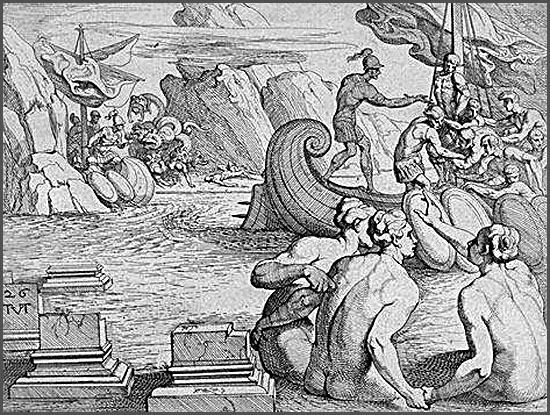Skylla barks
13 June 2006 - Who is Skylla?
“Incidit in Scyllam cupiens vitare Charybdim!”. In 'The Odyssey' Homer describes Skylla, or Scylla, as a barking-mad monstrous goddess who together with the whirlpool daemon Charybdis makes life hell for sailors and their ships in the Strait of Messina (between Sicily and Calabria, Italy). Any ship sailing too close to the sharp-toothed Skylla would lose six sailors, one for each of her six heads, whereas anyone sailing near Charybdis, who lives on the other side of the narrow strait, would risk being ship wrecked in her rough waters. It is this classic 'Catch 22' situation which the heroic Odysseus (the main personage in 'The Iliad' and 'The Odyssey') must confront. Armed with two spears he decides to fight Skylla, but whilst Charybdis averts Odysseus' attention six crew members are snatched away in a surprise attack by the invincible and bloodthirsty Skylla.
 [Skylla attacks Odysseus and his crew as the Sirens look on. Etching by Theodor van Thulden (Netherlands, 1606 - 1669), currently at the Museum of Fine Art in San Francisco.]
[Skylla attacks Odysseus and his crew as the Sirens look on. Etching by Theodor van Thulden (Netherlands, 1606 - 1669), currently at the Museum of Fine Art in San Francisco.]In the 1867 'A dictionary of Greek and Roman Biography and Mythology' (edited by William Smith) Leonhard Schmitz (PhD, FRSE and the Rector of the High School of Edinburgh) summarises Skylla as follows:
SKYLLA (Σκυλλα) and Charybdis, the names of two rocks between Italy and Sicily, and only a short distance from one another. In the midst of the one of these rocks which was nearest to Italy, there dwelt, according to Homer, Skylla, a daughter of Crataeis, a fearful monster, barking like a dog, with twelve feet, six long necks and mouths, each of which contained three rows of sharp teeth. The opposite rock, which was much lower, contained an immense fig tree, under which there dwelt Charybdis, who thrice every day swallowed down the waters of the sea, and thrice threw them up again: both were formidable to the ships which had to pass between them (from: Homer's Odyssey). Later traditions represent Skylla as a daughter of Phorcys or Phorbas, by Hecate Crataeis (from: Scholiast's Apollonius Rhodius), or by Lamia; while others make her a daughter of Triton, or Poseidon and Crataeis (from: Eustathius' Homer), or of Typhon and Echidna (from: Hyginus' Fabulae). Some, again, describe her as a monster with six heads of different animals, or with only three heads (from: Tzetzes' Lycophron, and Eustathius). One tradition relates that Skylla originally was a beautiful maiden, who often played with the nymphs of the sea, and was beloved by the marine god Glaucus. He applied to Circe for means to make Skylla return his love; but Circe, jealous of the fair maiden, threw magic herbs into the well in which Skylla was wont to bathe, and by these herbs the maiden was metamorphosed in such a manner, that the upper part of her body remained that of a woman, while the lower part was changed into the tail of a fish or serpent, surrounded by dogs (from: Ovid's Metamorphoses). Another tradition related that Skylla was beloved by Poseidon, and that Amphitrite, from jealousy, metamorphosed her into a monster (from: Tzetzes' Lycophron, and Servius' Virgil's Aeneid). Heracles is said to have killed her, because she had stolen some of the oxen of Geryon; but Phorcys is said to have restored her to life (from: Eustathius, Tzetzes, and Hyginus). Virgil's Aeneid speaks of several Skyllae, and places them in the lower world. Charybdis is described as a daughter of Poseidon and Gaea, and as a voracious woman, who stole oxen from Heracles, and was hurled by the thunderbolt of Zeus into the sea, where she retained her voracious nature (from: Servius' Virgil's Aeneid).
Published on 13.06.2006 by Sjaak van der Sar – Leave critique or other comments
